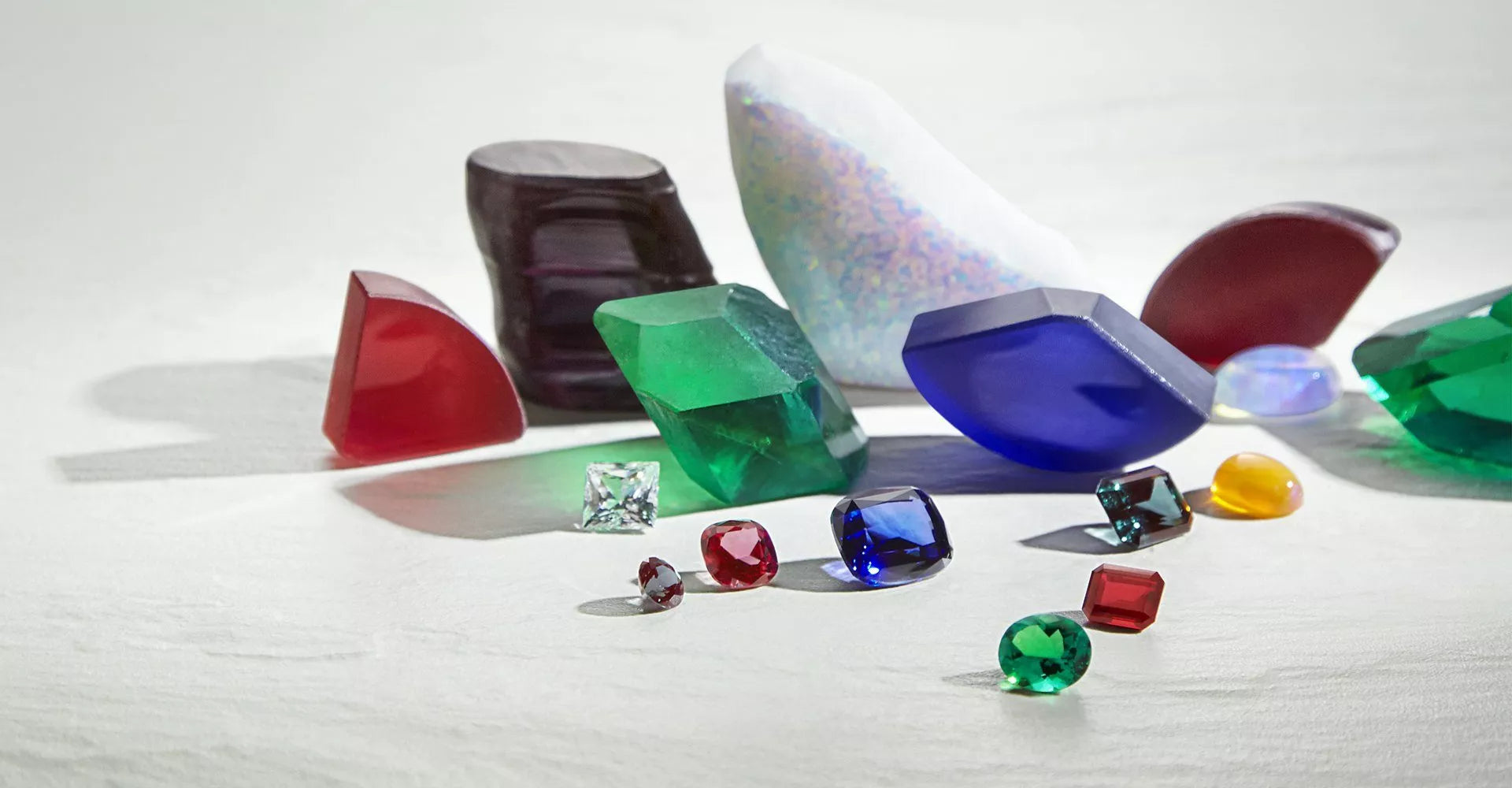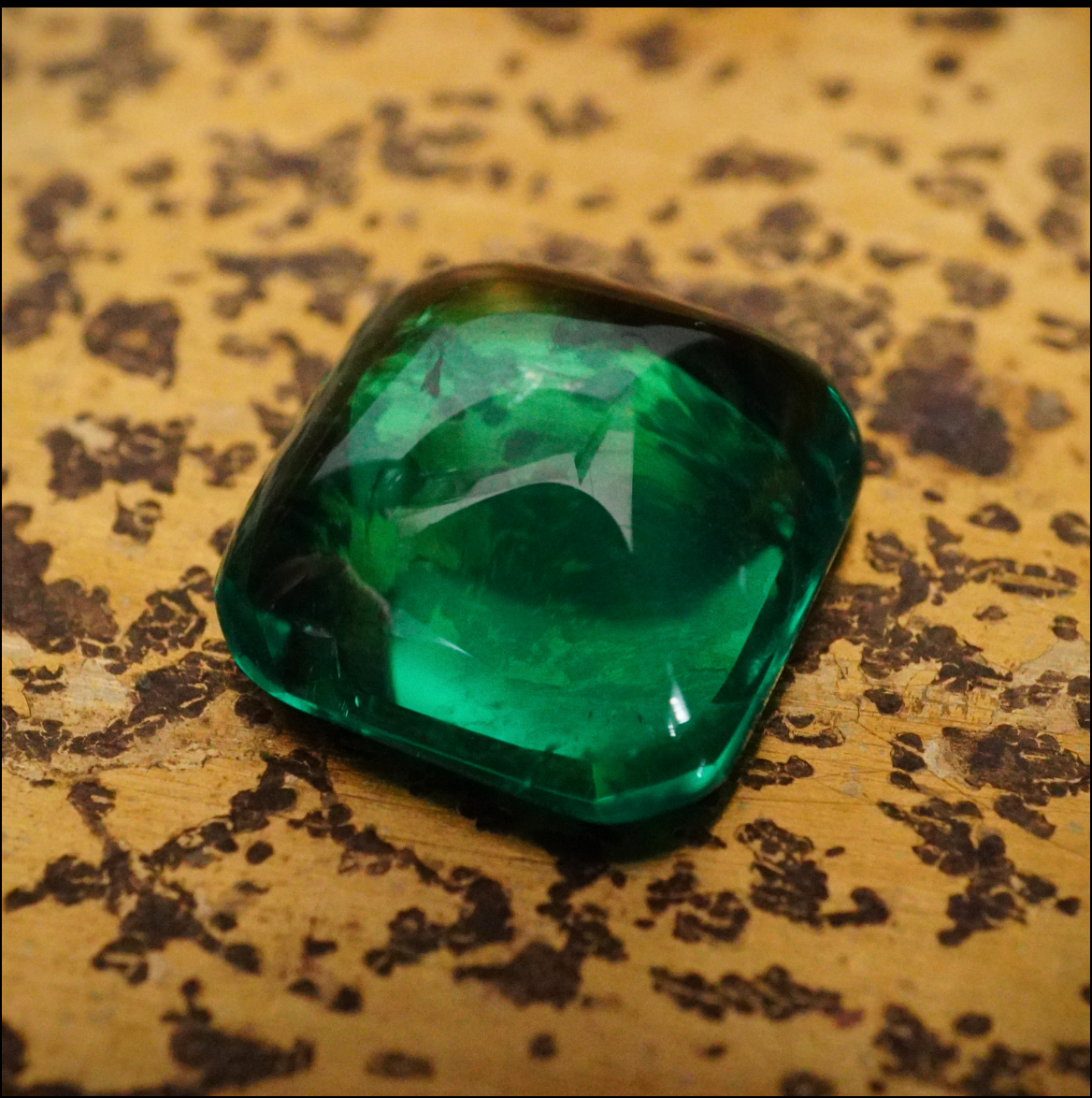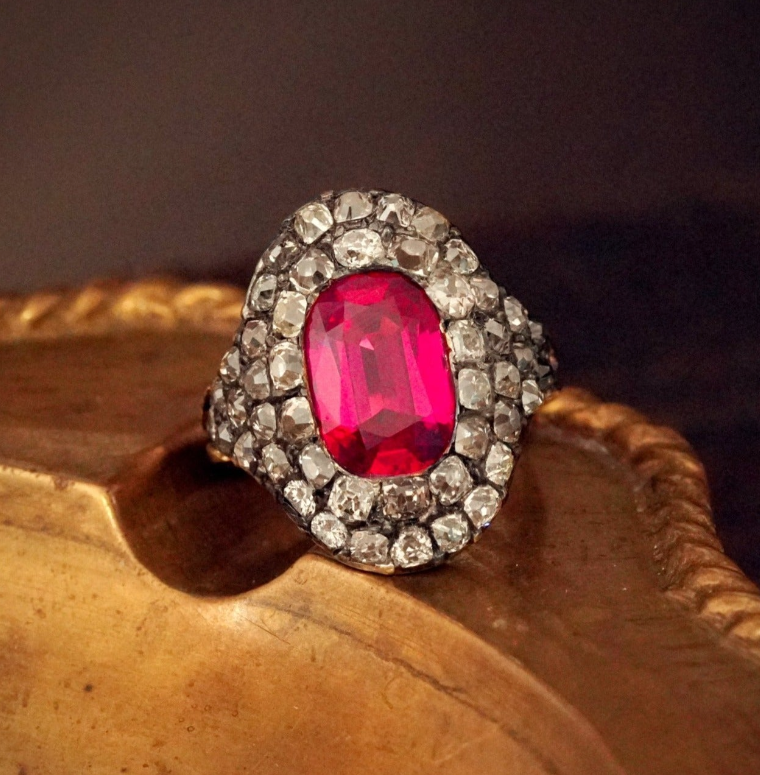
Antique Jewelry: Why It’s So Prized As an Investment
Antique jewelry, with its timeless allure, holds a cherished corner in the hearts of jewelry collectors, enthusiasts, and connoisseurs. But what makes these age-old adornments so highly coveted as investments? The answer lies in a remarkable confluence of factors that make antique jewelry not just irresistibly desirable but also inestimably valuable.
Inherent Rarity
Perhaps the most compelling reason why antique jewelry is so prized today lies in its exceptional rarity.
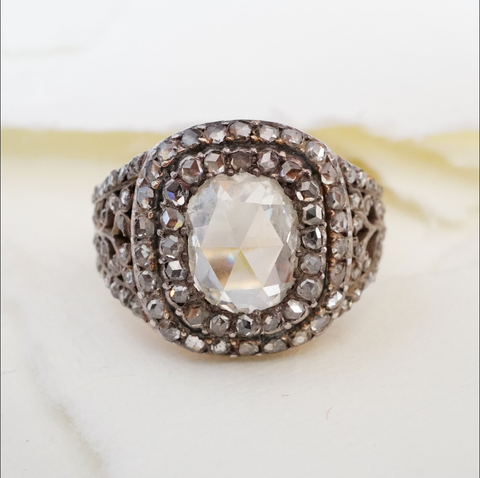
Antique rose-cut diamond ring.
Unlike the modern jewelry industry, which can flood the market with an endless stream of new designs and mass-produced pieces, many antique jewels are one-of-a-kind or highly unique, crafted with techniques and skills that have often been lost to time. Once these pieces are lost or destroyed, they’re gone from history forever.
The antique jewels that have survived are now treasured as tangible reminders of the artistry, culture, and history that defined bygone eras. Their inherent scarcity amplifies the sense of value associated with them, turning each piece into a precious relic of the past.
Master Craftsmanship
What further elevates the appeal of antique jewelry as an investment is the exceptional craftsmanship that went into creating these pieces.
In eras long past, jewelry artisans dedicated their lives to perfecting their craft. These master craftsmen meticulously attended to every detail, using handcrafted settings and often incorporating rare precious gemstones. The result? Jewelry that transcends mere adornment, becoming true works of art.
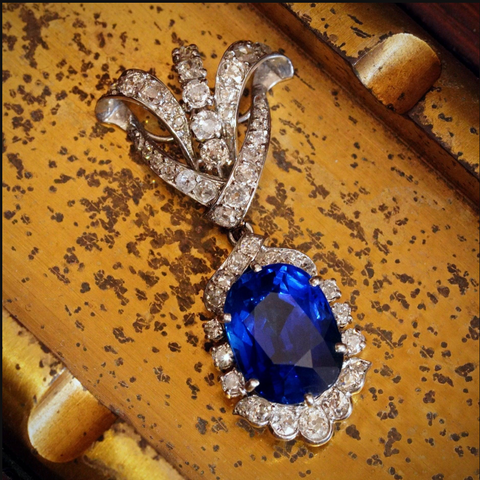
Vintage Van Cleef & Arpels brooch featuring a 14.77-carat, unheated Burmese blue sapphire and diamonds.
Modern techniques and technology may attempt to replicate the appearance of antique jewelry, but they seldom capture the depth of character found in genuine antique pieces. Emulating the magic of these timeless treasures is a challenge that few today can successfully undertake.
Historical Significance
Beyond the rarity and craftsmanship of antique jewelry lies a historical significance that gives great meaning to its desirability as an investment.
In centuries past, when the wealthy elite sought to display their affluence and make enduring investments, they often turned to precious jewels, the sole viable option of the time. The privileged few commissioned jeweled pieces that could take a year or more to complete, sparing no expense to acquire the finest gemstones and employ the most skilled jewelry experts.
These opulent and unparalleled pieces were more than just symbols of wealth; they embodied the eras from which they originated. This transformation imbues them with exceptional value today, as they serve as invaluable historical relics and representations of their respective times.
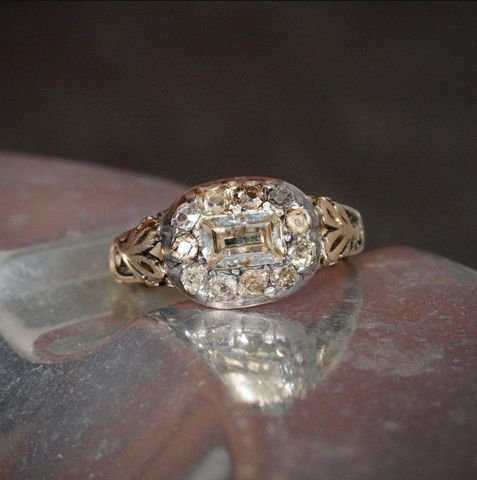
Georgian-era gold and silver ring featuring diamonds totaling two carats and floral filigree.
The Georgian era, which spanned from the early 18th century to the early 19th century (1714–1837), saw jewelry design leaning toward neoclassical aesthetics, featuring intricate metalwork, cameos, and gemstones such as diamonds and pearls. Georgian jewelry often exuded a sense of timeless elegance and sophistication.
Jewelry from the Victorian era, which followed from 1837–1901, can be traced through its distinct sub-periods. The early Victorian period, known as the Romantic period, epitomized sentimentality and symbolism, with intricate jewelry designs incorporating floral motifs, lockets for mementos, and gemstones bearing hidden meanings, often symbolizing love and devotion in response to Queen Victoria’s affection for Prince Albert.
As the era progressed, it transitioned into the mid-Victorian or Grand period, marked by a fascination with darker themes due to the mourning period following Prince Albert’s death in 1861. Mourning jewelry, crafted from materials such as jet and onyx, gained popularity, displaying remarkable craftsmanship despite its somber themes.
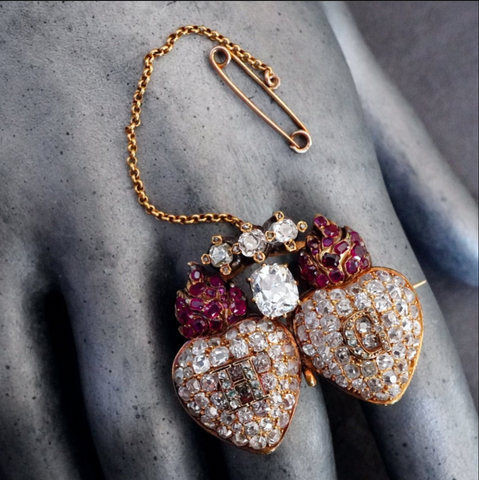
Victorian-era brooch featuring Old Mine–cut diamonds, rubies and two inseparable hearts with the initials "H" and "C."
Lastly, the late Victorian period, known as the Aesthetic or Artistic period, embraced lighter and more colorful designs, featuring vibrant gemstones such as amethyst, opal, and peridot, along with nature-inspired motifs such as flowers, birds, and butterflies, reflecting profound fascination with the natural world.
Another significant movement in the world of antique jewelry is the Edwardian era (1901–1910), which celebrated a resurgence of delicate and intricate designs. Platinum became the metal of choice, allowing for intricate lace-like filigree work adorned with diamonds and colored gemstones. Edwardian jewelry was characterized by its airy and ethereal appearance, reflecting the elegance and refinement of the era.
The Art Nouveau era, meanwhile, roughly spanning from the 1890s to the early 1910s, brought a significant shift in antique jewelry design. Characterized by its organic, flowing designs inspired by nature and the female form, Art Nouveau jewelry departed from the rigidity of Victorian and Edwardian styles. Sinuous lines, whiplash curves, and motifs such as dragonflies, butterflies, and sensuous women defined this movement. Opal, moonstone, and enamel work were frequently used, creating ethereal and dreamlike pieces. It represented a departure from traditional artistic constraints, embracing a more avant-garde and artistic approach to design.
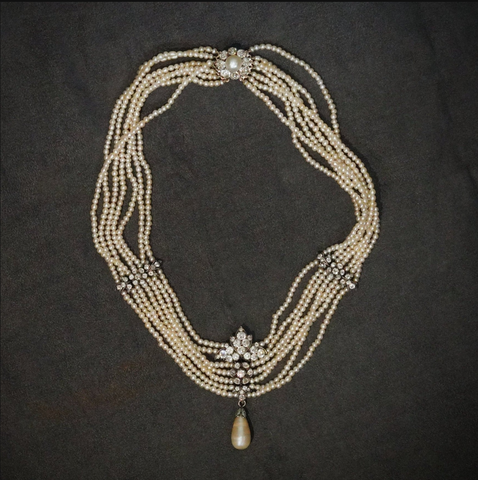
Victorian-era multi-strand natural-pearl necklace with pearl drop and diamonds.
The Art Deco era, which spanned from the 1920s to the 1930s, witnessed another dynamic evolution of jewelry design. This period embraced geometric shapes, bold colors, and a departure from the ornate styles of the past. Art Deco jewelry exuded a sense of modernity and sophistication, reflecting the cultural shifts and societal changes of the time.
The Retro era, during the mid-20th century, followed the austerity of wartime with bold, oversized pieces and a focus on colorful gemstones, particularly large and vibrant cocktail rings. Retro jewelry often incorporated yellow and rose gold, reflecting the glamour and exuberance of post-war optimism.
These antique jewelry pieces, whether from the Georgian, Victorian, and Edwardian eras, the Art Nouveau and Art Deco movements, or the Retro era, each carry a unique historical narrative, offering a meaningful and prudent investment in today’s diverse financial landscape.
Country of Origin
When considering antique jewelry as an investment, the country of origin also plays a pivotal role in determining the piece’s desirability and potential value. Throughout history, various regions have produced exceptional jewelry, each reflecting the unique cultural and artistic influences of its time.
The Mughal Empire, for instance, which spanned the Indian subcontinent from the early 16th century to the mid-19th century, is renowned for producing some of the world’s most exquisite gemstones and jewelry. Mughal jewels often featured intricate designs, incorporating precious gemstones such as diamonds, emeralds, and rubies. These treasures provide a fascinating glimpse into the opulence of the Mughal court, making them highly sought after by collectors and investors alike.
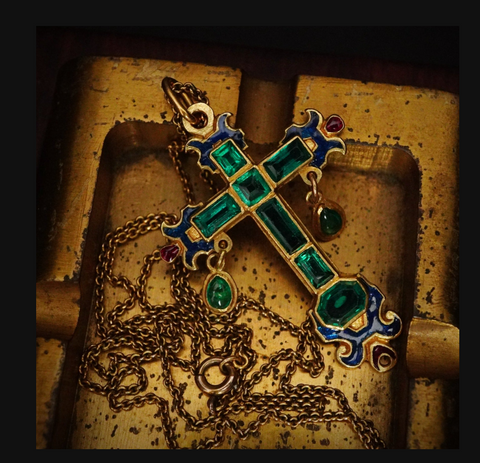
Antique cross featuring emeralds from the revered mines of Colombia.
During the 16th and 17th centuries, Portugal and Spain were prominent players in the global trade of gemstones and jewelry. These countries explored and colonized distant lands, bringing back an abundance of precious materials. Portuguese and Spanish jewelry often featured intricate goldwork and gemstone settings, showcasing the wealth and influence of these empires.
Europe has long been a cradle of jewelry craftsmanship, with various countries leaving their distinct mark on the world of antique jewelry. As mentioned previously, from the neoclassical elegance of Georgian jewelry to the delicate refinement of Edwardian pieces, European jewelry spans a diverse range of styles and eras. The jewels of Great Britain, France, and other European nations continue to captivate enthusiasts for their craftsmanship and historical significance.

Georgian-era ring featuring a 3.12-carat, unheated ruby from Burma, one of the world's leading producers of rubies, along with table-cut diamonds.
China also boasts a rich history of jewelry craftsmanship dating back thousands of years. Chinese antique jewelry is characterized by its intricate filigree work, the use of auspicious symbols, and the incorporation of jade, a highly prized gemstone in Chinese culture. Antique Chinese jewelry provides a window into the country’s deep cultural traditions and artistic heritage.
Country of origin is often considered when assessing the value of antique jewelry. Each region’s unique design aesthetics, craftsmanship techniques, and cultural influences contribute to the allure and narrative of these pieces, making them a compelling and meaningful investment choice.
The Growing Interest in Antique Jewelry Investment
In recent years, the allure of antique jewelry as an investment has surged, fueled in no small part by the power of the modern digital age. Platforms such as Instagram have proven to be game-changers in the world of antique jewelry investment. They serve as dynamic educational tools, allowing collectors, enthusiasts, and investors to delve into the design of these extraordinary pieces.
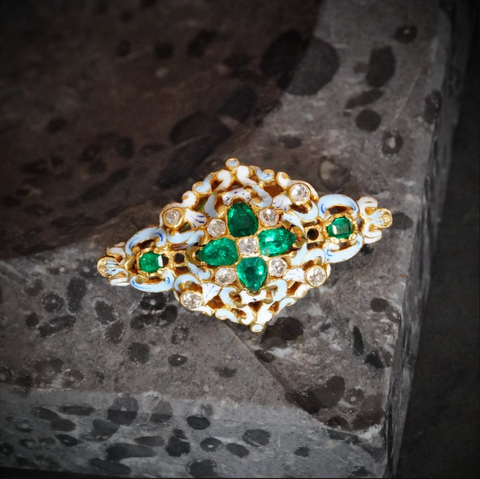
Renaissance Revival emerald, diamond and enamel brooch.
Social media platforms have also become a vibrant hub where antique jewelry aficionados and experts can share their knowledge. Antique jewelry enthusiasts can follow accounts dedicated to showcasing rare and historically significant pieces, where they can learn about the craftsmanship of each jewel, as well as its provenance and history.
This educational aspect has empowered investors to make more informed decisions, as they develop a deeper understanding of what makes certain antique pieces desirable and valuable.
Key Considerations for Antique Jewelry Investment
Beyond social media, antique jewelry experts and specialists play a pivotal role in guiding investors. These professionals possess an in-depth knowledge of jewelry history, styles, and market trends. Whether through consultations, seminars, or curated exhibitions, experts provide valuable insights that help investors navigate the intricate world of antique jewelry with confidence.
Auction houses, renowned for their expertise and rigorous authentication processes, are also trusted sources for acquiring antique jewelry. They offer a curated selection of often authenticated pieces with well-documented provenance. Auctions also provide a transparent platform where collectors and investors can acquire coveted items while enjoying the excitement of competitive bidding.
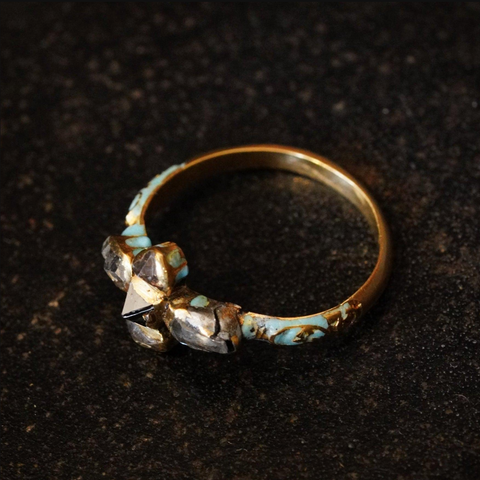
Renaissance-era point-cut diamond and enamel ring with cross motif.
For investors seeking assurance of authenticity and potential appreciation, antique jewelry pieces with designer signatures, ties to famous jewelry houses, or a history of ownership by notable individuals hold particular appeal. Such pieces often come with certification and documentation, verifying their authenticity and historical significance. Owning jewelry with a traceable history not only adds prestige but also enhances the investment’s potential for long-term value appreciation.
As interest in antique jewelry investment continues to grow, the combination of accessible education through digital platforms, the guidance of antique jewelry experts, and the availability of authenticated, historically significant pieces makes it an enticing and rewarding avenue for jewelry collectors and investors alike. With these resources at their disposal, individuals can embark on a journey that not only preserves the past but also helps secure their financial future.

Victorian-era brooch featuring a 2-carat, lozenge-shaped diamond and rubies.
Antique jewelry stands as a prized investment due to its unique combination of rarity, craftsmanship, historical significance, and country of origin. These treasures, surviving the test of time, not only captivate with their aesthetic beauty but also serve as tangible links to bygone eras. In today’s age, the availability of educational opportunities through digital platforms and the guidance of experts have propelled antique jewelry into the mix of investment choices. As we continue to explore this enchanting world, antique jewelry beckons as a source of both financial potential and a profound connection to history, making it an increasingly sought-after and cherished investment.
All antique jewels from the Jogani collection

